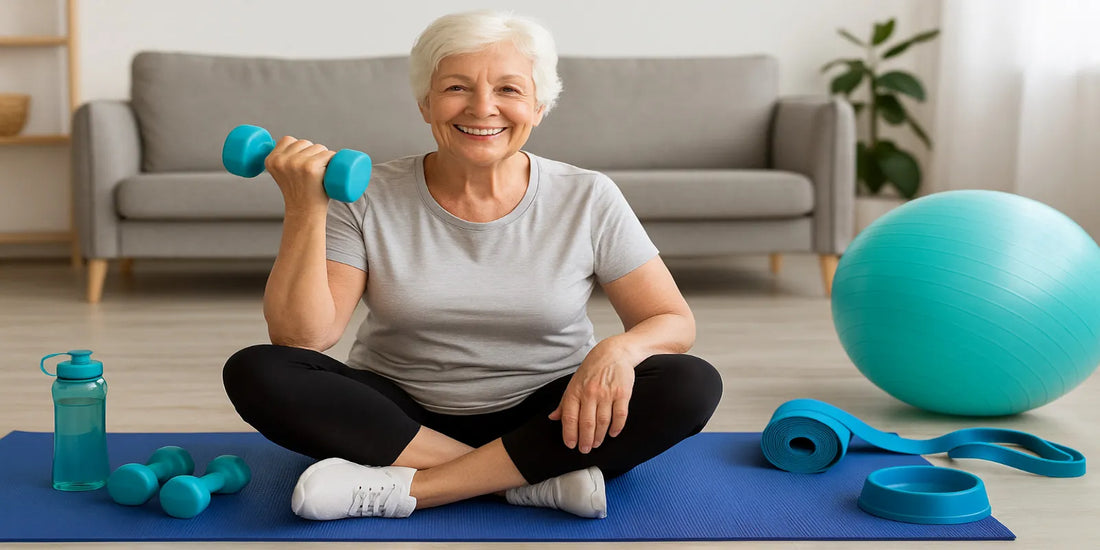
Senior Fitness Equipment 2025 – Safe & Easy Workout Guide
Share
Senior Fitness Tips 2025

Senior Fitness Tips 2025: Start Safe, Build Confidence
Turning fifty is not a stop sign; it is a smart reset. With the right plan, you can gain strength, protect joints, and feel steady on your feet. The simplest rule of Senior Fitness Tips 2025 is this: choose gentle movements you can repeat most days. Begin with a five-minute warm-up—march in place, roll shoulders, and breathe through the nose. Use the “talk test”: if you can speak in full sentences, your intensity is right. Aim for short sessions, consistent practice, and slow, controlled reps. Keep your space clear, use a steady chair for support, and wear shoes with good grip. If you feel pain, dizziness, or unusual shortness of breath, pause and check in with your body. A simple training log helps: write the date, exercises, sets, and how you felt afterward. Progress in tiny steps—add a few seconds, a couple of reps, or one extra round next week. This slow-and-steady approach lowers injury risk and builds confidence, which is the real engine of lifelong movement.
Authoritative guidance backs this approach. The CDC and WHO recommend at least 150 minutes of moderate activity weekly for older adults, plus two days of muscle-strengthening. The National Institute on Aging highlights benefits for mobility, mood, sleep, and brain health. Gentle resistance and balance practice are strongly linked to fewer falls and more independence, making Senior Fitness Tips 2025 both safe and practical.
Strength, Balance, and Flexibility—Your Daily Mini-Routine
Use bodyweight and household items to build a simple routine. Try sit-to-stand from a chair (2–3 sets of 6–10 reps), wall push-ups (2–3 sets of 6–10), and a hip hinge with hands on thighs to teach the body to lift safely. For balance, practice a heel-to-toe walk along a counter, or stand on one foot while holding the chair back lightly. Finish with flexibility: calf, hamstring, chest, and hip-flexor stretches, 20–30 seconds each, breathing slowly. Keep tempo controlled; a three-second lift and a three-second lower protects joints and builds muscle control. If you already walk, pair this routine with 10–20 minutes of easy walking on non-slippery surfaces. On busy days, split movement into two five-minute windows—consistency matters more than marathon sessions. Track how you sleep and how your knees, hips, and back feel the next morning. When the routine feels easier, add a second round or increase reps by two. If you prefer variety, alternate strength day, balance day, and stretch day; you will still gain benefits without burnout. This small, repeatable design keeps motivation high while reducing risk.
Research supports progressive strength for older adults. Reviews in journals such as British Journal of Sports Medicine and Cochrane associate regular resistance training with improved function and reduced falls. Combine that with balance practice, and everyday tasks—climbing stairs, carrying groceries, standing from the sofa—become noticeably easier within weeks.

Senior Fitness Tips 2025: Joint-Friendly Progressions
To progress safely, change one thing at a time. First, increase time under tension by slowing each rep; this builds strength without heavy loads. Second, tighten range of motion early—half squats, shallow wall push-ups—then expand as comfort grows. Third, add assists: hold the chair while balancing, touch the wall during calf raises, or slide a towel under your hands for smoother floor work. Fourth, rotate focus: strength on Monday, balance on Wednesday, mobility on Friday. This schedule delivers recovery and prevents soreness. Hydration, protein-rich meals, and seven to eight hours of sleep accelerate progress. Consider a pre-session check: “How’s my energy? Any unusual pain today?” If something hurts sharply, skip that move and choose a comfortable alternative—there is always another option. Finally, celebrate small wins: one extra rep, steadier posture during a one-leg stand, or a quicker walk around the block. Those small signals mean your plan is working.
For additional safety notes, review the NIA safety checklist. Speak with your clinician before starting if you have cardiovascular symptoms, uncontrolled blood pressure, chest pain, or new joint swelling. With these guardrails, Senior Fitness Tips 2025 becomes a sustainable, joint-friendly habit rather than a short-term challenge.
Senior Fitness Tips 2025: Weekly Template You Can Keep
Use this simple template and adapt it to your week. Day 1: Sit-to-stand, wall push-ups, heel-to-toe walk, gentle stretches (15–20 min). Day 2: Brisk walk or light cycling (15–25 min). Day 3: Chair-assisted squats, hip hinges, one-leg balance near a counter, chest and hip-flexor stretches. Day 4: Rest or easy mobility—neck circles, ankle pumps, diaphragmatic breathing. Day 5: Repeat Day 1 with one extra set. Day 6: Longer walk with a few pace surges; keep the talk test comfortable. Day 7: Rest, hydrate, and note wins in your log. If a day gets busy, split sessions into two ten-minute blocks; consistency is king. Keep your posture tall, shoulders relaxed, and steps short and light. Most of all, make it enjoyable—play favorite music, train with a friend, or reward yourself with a calm stretch and tea afterward. In a month, you will notice better energy, steadier balance, and more confidence in daily activities.
Sources: CDC Physical Activity Guidelines for Older Adults; WHO Physical Activity Fact Sheet; U.S. National Institute on Aging; Cochrane and BJSM reviews on resistance training and fall prevention.
